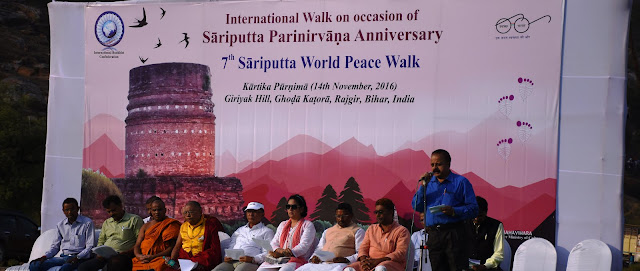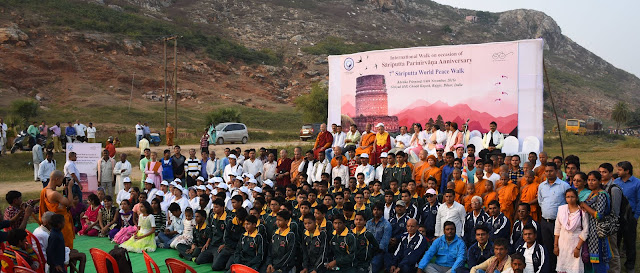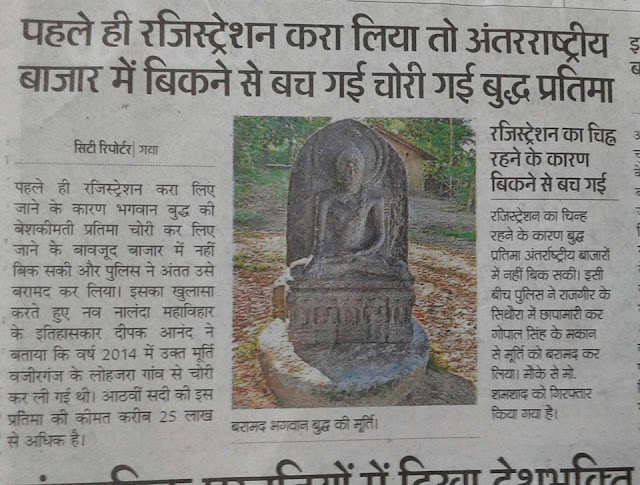International
Buddhist Confederation (IBC)
with support of Nava Nalanda Mahavihara (Deemed University), Nalanda and Bodhgaya Temple Management Committee (BTMC) successfully organized 7th Sāriputta
World Peace Walk at the base of Giriyak Hill, Rajgir on 14th November,
2016. Venerable Bhikkhu Saṅgha,
important dignitaries, community of Nalanda and staff and students of NNM
assembled at the start point of the Walk at 2.30 pm. Following the walk to the
base of the hill, Venerable Bhikkhu Saṅgha chanted Sammaditthi Sutta. The chanting was followed by the
speeches by the distinguished guests who spoke about contributions of Arhat Sāriputta. Objective of the event was to pay rich tributes and to generate
awareness towards the legacy of Sāriputta on occasion of his parinirvāṇa anniversary
on Kartikā Pūrṇimā (full
moon day of Oct-Nov).
Venerable Sāriputta
is one of the most prominent disciples of the Buddha who is considered to be
the right hand of the Buddha. For
centuries, the followers of the teachings of the Buddha inspired by the
contributions of Sāriputta to the Buddha, the Dhamma and the Saṅgha paid tribute to the stūpas built in
his native village.
Tradition maintains that Sāriputta attained parinirvāṇa six months before the Mahāparinirvāṇa of the Buddha. Sāriputta was born and he attained parinirvāṇa in a village near Rajgir and Nālandā. Pāli literature mentions the village Nālaka (also Nāla, Nālaka, Upatissagāma and Nālagāmaka) (SA.ii.172; ThagA.i.108; ii.93; ThigA.162), where Sāriputta attained parinirvāṇa. 5th CE Chinese monk-scholar Faxian (Fahein) corroborates this by mentioning the name of the village Nāla (Beal 2005), while 7th CE Chinese monk Xuanzang (Hsüan-tsang) mentions the name, Kālapinaka (Beal 1969). Identification of Sāriputta’s village based on Xuanzang and Faxian’s descriptions has led to village Naṇand (Prasad 1988: 175) and Chaṇdimau (Broadley 1979: 51), both in the proximity of Giriyak Hill. Our effort is to promote the whole area consisting of Chaṇdimau, Naṇand and Giriyak as Sāriputta Parinirvāṇa Zone.
Large stūpas were
built at the native village of Sāriputta by King Ashoka and the place was part
of the Buddhist pilgrimage as mentioned by Faxian and Xuanzang. Illustrations
from life and contributions of Sāriputta were discovered in numerous frescos
from the Tang Period (7th -9th CE) at Dunhuang Caves in China.
Sāriputta is also depicted in ancient Thangka paintings from Tibet. Sāriputta
is often seen flanking the right of the Buddha in many Buddhist temples around
the world.
The government of
Bihar has marked the day of the parinirvāṇa of Sāriputta as "Sāriputta
Divas”. This Day is in line with the Vesak
Purnima, celebrated as “Vesak”, to mark the day on which the Buddha
attained enlightenment and also his Mahāparinirvāṇa. Speaking
on the occasion, Ven. Lama Lobzang eminent monk and the founder of the IBC
thanked Government of Bihar for declaring the nirvāṇa day of Sāriputta as State day. He said
he will now urge the Government of India and Government of other Buddhist
countries like Sri Lanka, Burma, and Thailand etc to mark the nirvāṇa days of Sāriputta and Mahāmoggallāna
as National Days. He further added that from coming year the event should also
take place in the probable villages of Sāriputta i.e. Nānand and Chaṇḍimāu.
Dignitaries present
on the occasion,
1. Venerable
Lama Lobzang, Secretary General, International Buddhist Confederation.
2. Shri.
Chandrasen Kumar, Hon’ble MLA, Islampur.
3. Shri.
Nanzgey Dorjee, IAS (Retd.), Member Secretary, BTMC.
4. Shri. S
P Sinha, Registrar, NNM.
5. Ms.
Wangmo Dixey, Executive Director, LBDFI.
6. Shri.
Subodh Kumar, DCLR, Nalanda.
7. Shri Rajiv
Ranjan, Dy Collector, Rajgir.
 |
| Ven Lama Lobzang , Shri Nanzgey Dorjee, Ven Dhammajyoti and others |

 |
| Ven. Lama Lobzang leading the Walk. |
 |
| The Assembly after the Walk at the base of Giriyak Hill. |

 |
| Venerable Monks reciting Sutta |
 |
| Dr Sunil Sinha, Registrar, NNM giving the Welcome Address |
 |
| Ms. Wangmo Dixey sharing her views |


 |
| Shri Chandrasen ji, Hon'ble MLA sharing his views. |
 |
| Shri Raj Kumar Singh a heritage volunteer from a local villager sharing his views |
 |
| Ven. Lama Lobzang sharing his views |

 |
| Dr. Rana Purrushottam, Assistant Professor, NNM |
 |
| Dr Vishwajeet Kumar, Associate Professor, NNM giving the Vote of Thanks. |







 |
| A group picture of the participants |
 |
| Message of Hon'ble Chief Minister published in all the leading Newspapers of Bihar |


Bibliography:
Beal, S. 1969. Si-yu-ki: Buddhist
Records of the Western World, Translated from the Chinese Of Hiuen Tsiang,
New Delhi: Oriental Books Reprint Corporation.
Beal, S. 2005. Travels of Fah-hian
and Sung-Yun, Buddhist Pilgrims from China to India, New Delhi: Low Price.
Broadley, A. M. 1979. The Buddhistic
Remains of Bihar. Varanasi: Bharti Prakashan.
Prasad,
Chandra Shekhar.
1988. “Nalanda vis-à-vis the Birthplace of Śāriputra”. East
And West. Vol. 38. No. 1-4. Rome: Istituto Italiano Per Il Medio Ed Estremo Oriente.
Abbreviations
of Bibliography:
Source
of Pāli references: http://www.palikanon.com/english/pali_names/dic_idx.html
P.T.S. Means
published by the Pāli Text Society.
SA.
Sāratthappakāsinī, Saṃyutta Commentary.
ThagA.
Theragāthā Commentary, 2 vols. (S.H.B.).
ThigA
Therīgāhā Commentary (P.T.S.).

















